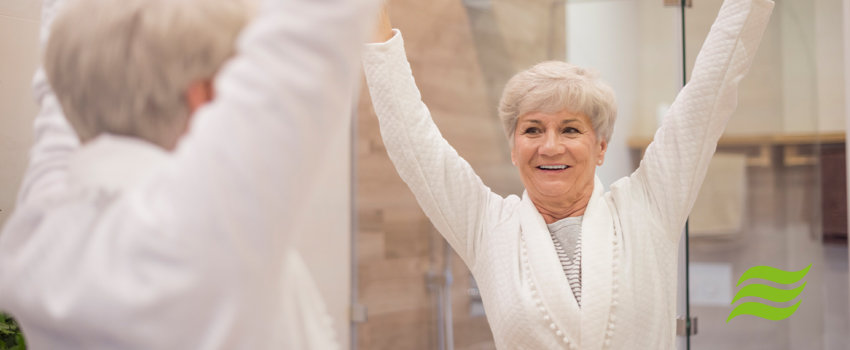
8 Ways to Make Bathrooms Safer for Seniors
Falls in the home can often lead to injuries for senior members of the family, but falls in a bathroom can be fatal. Bathrooms are hazardous places for the elderly, especially for those who suffer from balance-related issues.
Some of the common bathroom hazards for the elderly are:
- Slippery surfaces
- Low toilet seats
- Non-slip-resistant shower chairs
- Lack of grab bars
- Insufficiently secured towel racks
- Deep bathtubs that are difficult to get out of
- Steps down into the bathroom from the hallway
You can reduce the risk of falls and injuries to your elderly relatives by making a few changes to your bathroom.
1. Install secure grab bars
Grab bars are an essential addition to a senior-friendly bathroom, especially if they have poor balance or struggle to get in and out of the tub.
Many seniors will rely on towel bars to help steady themselves, but these aren’t designed to support a lot of weight so they can often break, causing serious injury.
By installing grab bars in places that are easy to reach, seniors will have no problem getting in and out of the tub and moving around the bathroom in general.
Grab bars are incredibly helpful for seniors who have good upper body strength but need help with balance while they’re moving around.
When installing grab bars, make sure they are slip-resistant and easy to see when placed on the walls.
There are two types of grab bars: suction cup bars or bars that are bolted to the wall. Suction cup bars have been known to come loose and slide down wet shower walls, which can actually increase the risk of injury.
If a bar slips down a wall, the senior might not realize and go to grab it where it usually hangs. Because the support has moved, they could lose their balance and injure themselves.
Bolted grab bars are affordable, safer, and they can help save you or your loved one from having a bad fall and getting injured.
2. Shower chairs
For seniors who have difficulty standing for lengths of time or struggle with their balance, a shower chair is an amazing, life-changing investment. Shower chairs will give them the stability they need to take a shower without the risk of slipping or falling over.
It’s best to get a chair that has rubber tips on the ends of the legs. That will stop the chair from sliding and allow it to grip better on a wet surface.
You can get simple shower chairs that are just stools you place in the shower. You can also get a bath/shower chair that is elongated on one side, which allows seniors to get in and out of the tub at ease.
3. Walk-in tubs/easy access showers
Walk-in tubs are a safe option for seniors who don’t want to risk slipping when getting in and out of their tub.
A walk-in tub has doors that allow you to walk in and sit down without having to worry about climbing over the ledge of a traditional tub.
Another option is easy access showers. These showers are designed with sloped floors to avoid curbs – enabling wheelchairs and walkers to roll in easily.
These are perfect for any senior who wants to be able to live more independently and worry less about slips and falls in their bathroom.
While we’re on the topic of wheelchairs and walkers, make sure there are no tricky flooring transitions into your bathroom. Remove any steps or curbs that can prevent those that need help moving from gaining quick and easy access to the facilities they need.
4. Use non-slip mats
Non-slip mats allow seniors to navigate bathrooms a lot more easily. They don’t have to worry about falling over or slipping on wet floors. Non-slip mats also minimize the risk of falling in the tub or the shower.
Placing non-slip mats in front of the shower, sink, and toilet will help prevent you or your loved one from slipping.
Non-slip mats are an absolute necessity if you’re elderly or share a bathroom with an elderly loved one. Falls from standing up in a slippery tub are preventable with these mats – and best of all, they’re pretty cheap to buy.
5. ADA-approved raised toilet seats
Seniors who struggle with lowering themselves down onto the toilet can really benefit from using a raised toilet seat.
These toilet seats are raised about three or four inches, and it makes it a lot easier to sit down for the elderly.
Installing grab bars near the toilet can also help assist with balance and reduce the risk of falls even further.
Most raised toilet seats do come already equipped with grip bars but adding additional bars to the wall will increase the safety and usability of the bathroom.
6. Make essential items easily accessible
Seniors might struggle to reach their toiletries while in the shower or bathtub without having to overstretch or bend.
By installing a shower caddy in the shower, you can make it a lot easier and safer to reach essential toiletries like shampoos and body washes. Mounted caddies are a lot safer than those that are suction-cupped as they’ll stay in place and won’t slide out of reach.
You can also opt for mounted dispensers on the wall of the bathtub or shower. This will prevent the bottles from slipping and falling from the user’s grip and help reduce the risk of falling.
Mounted dispensers are very inexpensive and easy to install. They’re easy to refill, too, and having them installed will get rid of the worry about bottles cluttering the shower and creating tripping hazards.
7. Change the lighting
Doing simple changes to your bathroom’s lighting can drastically improve safety.
Poor lighting can increase the risk of falls, so by having a well-lit bathroom, you or your loved one will easily be able to see what they’re doing.
Use night lights to make sure that the path from the bedroom to the bathroom is well lit, as this is a common area for accidents to happen.
8. Install a telephone in the bathroom
It’s a good idea to install a telephone in the bathroom. This will let seniors call for help or assistance if they need it – whether that’s to someone else in the house or 911 if needed.
Having a waterproof medical alert system should also be considered to improve the safety of the bathroom.
Bonus tip: Widen your doorway
Often overlooked, but incredibly important are door openings (both shower & entry doors). According to ADA standards, the clear width of a door opening must be a minimum of 32 inches.
This clear width measurement is taken between the face of the door and the stop of the frame with the door open to 90 degrees.
This measurement gives those using wheelchairs or walkers plenty of room to maneuver into and around the bathroom.
